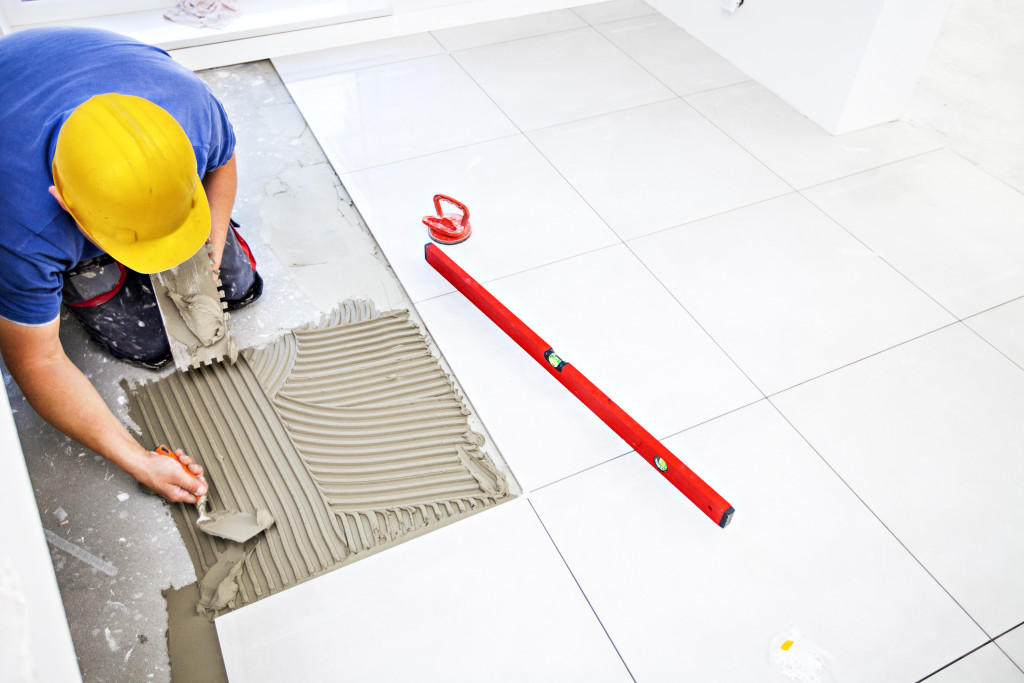Tiles are a beautiful feature of a home. They come in different sizes and designs that can serve multiple purposes but most of all as flooring. Many folks prefer tiles for being easy to clean and their inability to gather dust mites. But even then, they still need maintenance.
If there’s sanding for wooden floors, there’s getting rid of grime in between tiles. Cleaning tiles isn’t all there is. Unfortunately, you’re going to have to get into the grout too. Over time, they can start to darken because of the dirt and grime building up in this hard-to-reach space.
What Is Grout?
Grout is a liquid-like substance that is utilized as concrete and adhesive, especially for tile installations. It’s used to fill the gaps between tiles to prevent moisture from seeping down into the underlayment. Grout has three main types: cementitious grouts, epoxy grouts, and furan grouts.
Furan grouts usually come in black while Cementitious and epoxy are available in different colors. This makes the two easy to match with the chosen tiles to install. The difference between the two is that their contents are entirely different from each other. Cementitious grouts have filler particles, a water-retentive additive, and lastly Portland cement which is the main component that makes up this grout. On the other hand, epoxy grouts consist of epoxy resin, silica fillers, and a hardener.
Why Does Grout Get Dark Over the Years?
Homeowners might notice how the grout lines on their kitchen floor have darkened over time. This is often the result of too much cleaning detergent or soap. While cleaning the tiles, the water and soap fall into the grout lines, carrying with them the dirt from the tiles. This builds up over time causing the grout lines to gradually appear darker and darker. However, other things contribute to their darkening such as grime, oils, sediment, and even mold.
Mold growth can be concerning. It’s often found in wet spots and rooms with moist conditions, such as the bathroom. Red mold, a type of fungi, is one that’s commonly spotted in bathrooms, and even in grout lines.

How Do I Get Rid of Grout?
There are multiple ways to help get rid of grout. Here are some ways to do so. Hopefully, at least one of these options will not require you to put too much effort into scrubbing!
Vinegar and Water
The bathroom is a perfect environment for red mold to thrive in. Being humid and constantly exposed to water and soap, these eventually make their way into the grout lines and build up over time. For this, make a solution consisting of one part water and one part vinegar. Put this solution in a spray bottle, and let it sit for five minutes. Spray the solution on target areas, and scrub away with a toothbrush.
Vinegar and Baking Soda
Another solution worth trying is a mix of vinegar and a pinch of baking soda. Mix until it creates a paste-like consistency. Apply this to the affected areas, and leave it there for five minutes. Once again, scrub with a toothbrush and then rinse with warm water.
Oxygen Bleach
If the homemade solutions aren’t doing the trick, it could be time to hit the nearest store and get a bleach product.
Oxygen bleach comes in two forms, liquid, and powder. Although the liquid is ready to use, it might not be worth your buck as they often come in small spray bottles. Buy the powder ones instead. Add water to the powder as advised by the manufacturer. Once the tiles have been cleaned, spray or apply oxygen bleach onto the grout lines. Let the product sit for at least five minutes. With a toothbrush, brush thoroughly. Rinse with warm water.
Chlorine Bleach
For very stubborn grime and dirt, mix chlorine bleach with water. One part bleach and three to four parts of water should do the trick. Keep in mind that chlorine bleach is very abrasive, and if you scrub too hard it may cause the grout to crumble.
Hydrogen Peroxide
Hydrogen peroxide can be used by itself or create a paste with it using baking soda. Apply it on the surface of the affected area, and scrub with a brush. Rinse with warm water.
How Often Should Grout Be Cleaned?
Ideally, grout should be deep cleaned once a week. Light cleaning such as wiping and spraying should be done every day. However, there are factors to consider when it comes to how often you should be cleaning. Factors like the number of people that live in your home, the kind of lifestyle you live, and more.
However, if you decide to clean as often as every week, avoid using abrasive cleaners such as bleach. Although it’s effective, long-term use will strip the color from, the grout and even cause them to break and crumble. Instead, use homemade cleaning solutions for a milder and still effective means of cleaning and use bleach once or twice a month.
Extra Tips
Here are some friendly reminders when cleaning in between tiles.
Clean the Tile First
Before applying or spraying the cleaning product onto grout lines, be sure to clean the tiles first. The dirt found on the tiles will only creep into the grout, contributing to another layer of dirt. Having that out of the way will make cleaning more efficient.
Wear Safety Gear
Wear rubber gloves, a face mask, and clothes you don’t mind getting dirty, especially when you’re cleaning with bleach. Bleach can be painful when it comes in contact with the skin and should be avoided at all costs.
Ventilate the Area
When cleaning with bleach, it’s important to keep windows open or run the fan to prevent prolonged exposure and breathing in its fumes. It can be toxic when kept in a contained area for a long period.

